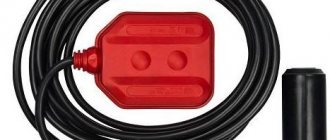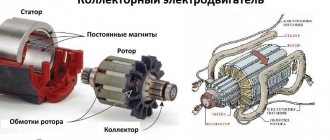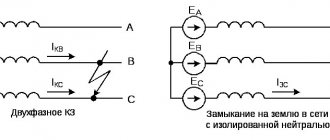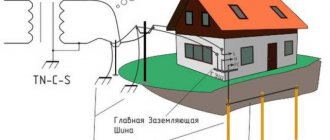If everything is very clear with the common heating element models of electric boilers, then not everyone has an understanding of the operating principle, advantages and disadvantages of electrode heating boilers. This is due to inflated statements by marketers claiming incredible savings and, conversely, with reviews from owners who are convinced that this is not entirely true.
In fact, electrode boilers are ordinary electric boilers, slightly different in operating principle, compact size and lower cost. But whether it is worth using them for heating a private house and how true all existing opinions are, we will find out by analyzing the principle of operation and the differences from standard heating element electric boilers.
Operating principle of an electrode boiler
Electrode boilers operate from alternating electric current with a frequency of 50 Hz. The name itself, electrode boiler, says that the boiler contains electrodes; they can be called plus and minus. The designation of the plus and minus poles is arbitrary, since the potential changes 50 times per second.
The coolant for electrode boilers has a special chemical formula that ensures ionization of the coolant with the release of a large amount of heat. The chaotic movement of ions and the constantly changing potential of alternating current increases heat generation.
Characteristic
An electrode boiler (also called an ion or ion exchange boiler) differs from other units operating from the network in that it has an open electrode to which current is supplied.
Refers to direct heating heating devices in which heat is directed directly to the energy carrier. This makes it possible to instantly increase the power of the structure, because there are no obstacles in the heat transfer process.
Heating is carried out using electrodes that are immersed in a tank of liquid. Current is conducted through the coolant with a frequency of 50 Hertz and creates a barrier to electrolysis. Therefore, the inside of the boiler remains free of scale deposits.
The heating process of the liquid occurs with the help of resistance that appears. This happens very quickly. Thus, the container (tank) may not be large in size, since it is not necessary to wait for the liquid to be heated by the element. Such design properties of this boiler allow you to save the user’s budget by reducing energy consumption in the heating system.
An electrode heating boiler is very sensitive to the composition of water; ordinary tap water cannot be used to operate the unit.
Before installation, special preparation of the liquid is required. It’s good if there are antifreezes available that are recommended by the manufacturer.
Antifreeze for the heating system can be made based on ethylene glycol and propylene glycol. More details at.
It also has another feature, which is the gradual dissolution of the electrodes. This is a natural process, its acceleration and deceleration depends only on the intensity of use of the heating system.
Advantages of an electrode boiler
First of all, this type of electric boiler is not afraid of voltage drops. The process of ionization of the coolant will also take place when the voltage drops to 180 Volts. This is a great advantage, especially for areas with unstable power supply.
Secondly, the operating principle of these boilers allows them to be very small in size. Everyone is familiar with the previously frequently advertised Galant boilers. Example in the photo.
Thirdly, electrode boilers are safe. Again we return to the principle of operation. If the coolant disappears from the system, the boiler simply will not work. There will be no emergency situations, which means there is no need for automatic monitoring of the presence of coolant.
Fourthly, unlike heating elements of boilers, scale does not form in electrode boilers and their service life is extremely long.
Features of installation of electric boilers
One of the advantages of an electric boiler is its relatively simple installation compared to gas or solid fuel counterparts.
Installation does not require a separate room, there is no need to organize a chimney, and a variety of boiler designs allows you to choose a boiler that fits harmoniously into the existing interior. The electric boiler is connected to the network using a separate cable. It should be taken into account that to connect small boilers with a power of up to 6-7 kW, a single-phase 220 V network is sufficient; for boilers from 12 kW and above, a three-phase 380 V network is required. Depending on the power consumption, you need to select a cable of the appropriate cross-section. Typically, for 8 amperes of current, a 1 mm² cross-section is sufficient. To reduce the risk of boiler breakdown due to voltage surges, a protective shutdown device must be installed.
It is entirely worthwhile to install remote remote sensors that monitor the temperature directly in the premises. Most models of modern boilers are produced complete with the necessary equipment. One housing compactly houses a circulation pump (in double-circuit boilers two pumps can be used - separately for the heating and hot water supply circuits), an expansion tank, a safety valve, an air vent, a thermomanometer, a dry-running protection relay, a mechanical or electronic power regulator and other equipment. A more complete set ensures the correct selection and coordinated operation of all elements of the system; in addition, the costs of installing each device separately are reduced.
Among the additional but necessary equipment, it is worth mentioning storage tanks with good thermal insulation. Such a container is installed at the outlet of hot water from the boiler and performs several functions at once:
— retains a certain volume of hot water even when the boiler is not working from several hours to several days. The water supply can be used both in the heating system and for hot water supply; — allows you to balance the use of various heat sources (gas, solid fuel boiler and others); — protects the boiler and the heating system as a whole from overheating; — allows you to heat a certain supply of water at a cheaper (night) rate.
Installing thermostatic regulators on each heating radiator will allow you to more accurately regulate the temperature in individual rooms and significantly reduce energy consumption.
Flaws
Ionization of “pure” water will not occur. And here lies the first drawback of electrode boilers. Water for filling a heating system with an electrode boiler must be distilled and requires preparation or a coolant requires purchase. It is recommended to add soda or salt to water in a volume of 5-8 mg per 100 liters.
Secondly, we return again to the principle of operation, in fact, the alternating current in this boiler flows through the coolant, which means that current leaks are possible to the metal devices of the heating system, in particular radiators. This obliges, when installing electrode boilers, to strictly observe grounding rules and protect people from differential currents.
Third. I said above that electrode boilers do not suffer from scale formation. However, the opposite effect is observed in them. The boiler electrodes become smaller over time, as they constantly “give up” their particles. This means that over time the electrodes will need to be changed. How often? As often as in heating element boilers, once every five years, possibly more often.
Self-installation rules
We will not describe in detail the scope of work for installing radiators, connecting metal-plastic pipes and connecting them (supply and return) to the boiler terminals.
You can see all these stages in the video instructions, which demonstrate the technology for connecting the Galan electrode boiler, which is very popular today: Video instructions for DIY installation
https://youtube.com/watch?v=Ox2KDB8DVG0
As you can see, the installation is not complicated, all you need is to connect the pipes, make grounding, connect the automation and make the settings. Even the factory instructions for the equipment describe in detail the entire scope of work. It is much more important to tell you about what rules you need to take into account when installing an electrode boiler with your own hands. So, in order for the system to work for a long time and without emergency situations, we advise you to follow the following recommendations:
- Adjust the coolant (water) according to the requirements of the equipment manufacturer. For example, the Galan company strongly recommends using Argus-Galan liquid as a coolant for such models of electric boilers as Vulcan, Geyser and Hearth, which must be changed independently every 5 years. For the Galan-BeeRT model, you need to use only distilled water. At the same time, the use of antifreezes such as “Arktika” and “Tosol” is strictly prohibited.
- Be sure to flush the old heating system from salt deposits (this requirement is not relevant for a new pipeline). The fact is that contaminated radiators will negatively affect the density of the coolant, which can even worse affect the operation of the electrode boiler. For flushing, it is recommended to use an inhibitor called “Protector”.
- Under no circumstances should the device be connected to the network without grounding. It is recommended to use copper wire with a cross-section of 4 mm2 and a resistance of no more than 4 Ohms as a PE conductor.
- The optimal coolant consumption is 8 liters per 1 kW of equipment power. We do not recommend going beyond this value, because... This consumption allows you to save maximum energy.
- At the highest point of the system, you need to install a deaerator valve (in simple terms, an air vent) to bleed air, as well as a pressure gauge and a non-return safety valve.
- All shut-off valves must be installed behind the expansion tank (as shown in the electrode boiler connection diagram).
- The heater body must be installed in a strictly vertical position, as shown in the photo. Any distortion will negatively affect his work.
- When choosing new radiators, buy products made of bimetal or primary aluminum. Such metals contain the least amount of impurities that have a negative effect on the electric boiler.
- Under no circumstances use cast iron batteries when installing an electrode boiler with your own hands. Such products quickly become dirty and also consume more coolant, which will reduce the efficiency of electric heating significantly.
- You can install several heaters in series (as shown in the video) if the power of one is not enough. It is recommended to use a group of boilers when installing heating in a two-story house (for example, one water heater will serve the first floor, and the second, respectively, the second).
That's all I wanted to tell you about how to connect an electrode boiler in a house or apartment. We also recommend watching a video that talks about the advantages of using EOU - flow-type electrode heating systems, which are popular today.
Advantages of using EOU
Related materials:
- How to connect an electric boiler to the network
- Advantages and disadvantages of heated floors
- Economical methods of electric garage heating
Galan electrode boiler models
Single-phase models "Ochag"
- Galan OCHAG 3. This model is a single-phase ion-type boiler. Suitable for rooms up to 40 meters or 120 cubic meters. There are several configurations.
- HEATH 5. This is a single-phase model for up to 70 meters or 230 cubic meters.
- OCHAGA 6, Also a single-phase model for rooms up to 90 meters or 280 cubic meters.
Three-phase Geyser models
- Geyser 6 (380 V) for rooms up to 100 meters or 250 cubic meters.
- Geyser 9 for rooms up to 125 meters or 340 cubic meters. Can be connected to 220 or 380 V.
- Geyser 15 will heat 203 meters of area or 550 cubic meters of space.
Powerful electrode boilers not used for home heating
- Vulcan 25 will heat any room, power step 25 kW.
- Vulkan-36 will heat any room, power step 36 kW.
- Galan Vulcan 50 will heat any room, power step 50 kW.
That's all about electrode electric boilers!
©Obotoplenii.ru
Articles on the topic
- Heating scheme for a house up to 100 meters
- Glass heaters
- Baseboard heating: description, application
- Heating the house with an electric boiler
- Electric heating boiler (electric boiler): device, connection to power supply
How to do it yourself?
Before you begin directly assembling an ion heat generator with your own hands, you need to take into account several important nuances of this process:
- The boiler , first of all, must be reliably grounded, since such an installation has an increased probability of electric shock to a person during its operation.
- The zero wire from the power socket of such a unit is connected only to the outer pipe.
- The power phase is connected only to the electrodes themselves.
Materials you will need:
- welding machine;
- steel pipe of appropriate length and cross-section;
- one or a set of electrodes;
- closing marks for wires to zero and grounding;
- insulating stamps and electrodes materials;
- coupling and metal tee;
Installation:
- The technology for manual installation of this unit is quite simple. In a steel pipe approximately 250 mm long and with a diameter of 50 to 100 mm, which depends on the power of the block with electrodes, electrodes are mounted on one of its sides using a tee. Also, the coolant will move through the tee. The opposite end of the pipe is equipped with a coupling for connecting to distribution pipes and radiators.
- The electrode is installed in one of the tee pipes on an insulator , which at the same time seals the boiler structure. One of the heat-resistant plastic options is selected as it. To ensure tightness and detachability due to the threaded connections of the tee and electrode, it is best to order the insulating element from a turning workshop according to the appropriate dimensions.
- onto the body of the heat generator , made of a steel pipe, to secure the neutral wire and grounding marks on it. For reliability, the design is sometimes duplicated with another bolt. All elements of a heat generator assembled with your own hands can be covered with a decorative box, which will also protect people from electric shock in the event of a breakdown of the internal insulation. This limitation of direct contact with metal parts of the boiler body is extremely important to ensure safety.
After installing the device, insulating it, connecting it to distribution pipes with radiators and installing plugs on the pipes, fill the system with clean water with an approximate salt content and connect the unit to the network for a test run. The salt content in water is adjusted in such a way as to achieve its optimal current resistance measured in Ohms.











